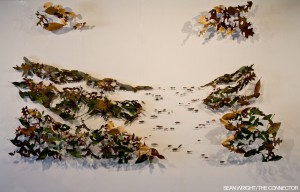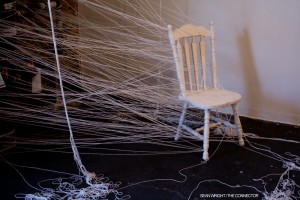Despite the inclement weather Feb. 12, six artists and a professor put up a multidimensional installation exhibit at Studioplex.
Martha Whittington, a professor of fine arts at SCAD, said she challenged six students in her alternative media course — Monica Ellis, Naedra Fox, Danielle Freeman, Tijana Graham, Jennifer McHugh, Stephanie Pharr and Chelsea Smith — to use the gallery environment in the same way they would use a canvas or any other surface.
“The result being an interesting show that involved performance, video and ephemeral works,” Whittington said.
The show was only temporary, though.
“We thought that if it would only last a short time, we should have a show and make sure that people see the work during its short lifetime,” said McHugh, a third-year painting student.
Graham, a fourth-year painting student, created a neon colored ice sculpture melting on a Georgia clay-covered canvas to highlight areas of the state that were affected by the drought. “It is the reminder of our vulnerability to climate change,” Graham said, “The path chosen to resolve the water issue will shape the future for the region’s economic and environmental outlook as well as the quality of life for the residence of the state.”
Smith endured a performance by lying on a bed of crayons for 2 hours, Whittington said.
Ellis, a fourth-year painting and animation double major, used hundreds of feet of white yarn to cocoon existing drain pipes in the gallery.
“The cocooning stretched off the structure, gently encasing a vintage white chair giving the illusion that if you approached the yarn too closely, you might also be encased,” Whittington said.
McHugh said her piece was a large landscape created out of leaves she collected.
“The lights created beautiful shadows on the wall. So different parts of the landscape were set at different distances from the wall.  Some of the leaves had silhouettes of figures cut out of
Some of the leaves had silhouettes of figures cut out of
them, which created exciting nuances within the piece,” McHugh said.
Whittington said Pharr challenged the viewer with the shiny white industrial cube she created. Pharr set up two video monitors; one showing a video of a woman painting her face white, but in reverse. This created a shift in the perception of the order of things before a viewer approached the cube.
“Once at the cube, which was big enough to house a person, you viewed a video of a women painted white in a strangely familiar setting,” Whittington said, “The same cube was turned inside out.
“You noticed that the cables from the video monitor were being fed into the cube. The viewer’s experience was of what is on the surface and what [was] hidden beneath the surface.”
Fox created an environment using nails. Her rectangular structure was designed for the viewer to enter and create a visual shift in the gallery space as the viewer peered into the space through a screen covered in nails.
McHugh said the most successful things about the show were probably what seemed like the worst at the time.
“We put our installations together in a fairly crunched amount of time, but I believe that doing these things with a set time limit is good career preparation,” she said.
Graham said what made the show so strong was the interaction and collaboration between the artists during the creation
of the pieces.
“The result was a layout that created a fluid tone while preserving the creative differences and talents of each artist and enhancing the overall experience for the viewer,” Graham said.

























